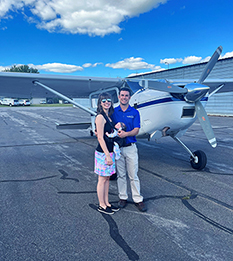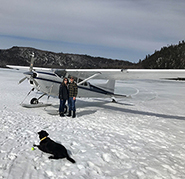by Dave Weiman
Published in Midwest Flyer Magazine April/May 2023 Digital Issue
Since 1954, Becher-Hoppe Associates, Inc., with offices in Wausau, Wisconsin, has provided engineer consulting and survey services throughout the state, specializing in airports, highways, and municipalities. The firm also provides real estate appraisal and acquisition services, and in more recent years, aerial drone photogrammetry.

Always on the lookout for new talent, the firm feels it made the right decision when it hired Karl Kemper straight out of college. Kemper is not only a skilled engineer, but shortly after getting hired, he realized that becoming a general aviation pilot and aircraft owner would enhance his career and fulfill some lifelong dreams as an avid sportsman.
But Kemper was not the first employee at Becher-Hoppe to embrace general aviation. Becher-Hoppe founder, Archie “Skip” Becher, Jr., owned and flew a cabin-class, twin-engine aircraft for years. Randy Van Natta, who started with the company in 1979, and has been President and Chief Executive Officer since 2004, is also a pilot and equally passionate about general aviation.
On December 31, 2021, Van Natta, and Archie C. Becher, sold the company and its real estate holdings to fellow employees Karl Kemper, Matthew Graun, and Jed Mattmiller. Kemper was named President; Graun, Vice President; and Mattmiller, Partner. This is the fourth generation of internal ownership transition within the company, which is something the company is very proud of.
 Karl Kemper and his wife, Chelsey, grew up in the small town of Manistique in the Upper Michigan Peninsula. They graduated from high school in 2008, and Karl from Michigan Tech in 2012 with a degree in Civil Engineering.
Karl Kemper and his wife, Chelsey, grew up in the small town of Manistique in the Upper Michigan Peninsula. They graduated from high school in 2008, and Karl from Michigan Tech in 2012 with a degree in Civil Engineering.
“I had interned as a Wisconsin Department of Transportation highway construction inspector with another civil engineering firm in the Wausau area each summer while in college,” Karl said. “After graduation, the firm wanted me to gain experience working out of their main office in Milwaukee. I know the company had the best of intentions for my career and development, but I’m not a big-city guy, and didn’t want to risk getting stuck down there long-term with Chelsey. So, I stopped by the Becher-Hoppe booth at the Michigan Tech career fair and had an interview set up with them in Wausau soon afterwards.” In January 2013, Karl Kemper went to work for the company.

Initially, Karl expected that he would be working as a highway construction engineer, but Van Natta instead assigned him to an airport project at Price County Airport (KPBH) in Phillips, Wisconsin. There he worked on constructing a parallel taxiway, extending a runway, creating a hangar development site, and removing obstructions.
“Did I really have a choice?” asked Karl. “Randy said it would be ‘just like building a highway,’ except better, because I didn’t have to deal with aggravated motorists driving through work zones, landowners who were upset because we were blocking their driveways, etc.”
That project won the Wisconsin DOT Bureau of Aeronautics Construction Project of the Year Award in 2013.
“Next came a big project at Sawyer County Airport (KHYR) in Hayward, Wisconsin, to install an ILS,” said Karl.
“Again, did I have a choice?” reflected Karl, who didn’t yet know what an ILS was.
The project at Hayward was more than just installing an ILS, though. A parallel taxiway was needed, which required relocation of a road that resided where the taxiway was to be built. A lot of tree-clearing was needed. The airport is surrounded by wetlands, so there was a lot of care that needed to be taken around them, related construction challenges, and a lot of environmental coordination. A Medium-intensity Approach Lighting System with Runway alignment indicator lights (MALSR) needed to be installed, and a road was built over the wetlands to maintain the system. A concrete apron expansion was also included.
Van Natta would fly to Hayward to check on the project’s progress, and when the project was done, he flew Karl up there for final inspections and project closeout coordination.
“I had only flown commercially a handful of times when I was growing up, and I didn’t like it,” said Karl. “In fact, flying scared me, and I’m still scared of heights to this day, except in airplanes. I had to psych myself up to get in the plane with Randy. But I started to see the benefits of flying, not only in terms of time savings, but also to develop my career. Besides, getting to Hayward in 45 minutes in an airplane versus 3 hours by car, helps. I also noticed that Randy had an incredibly deep knowledge of airports from being a pilot, which helped to make him a great airport engineer. I also began to think about personal travel opportunities if I were to get my pilot’s license.”
Around this time, Karl started a project at Wausau Downtown Airport, just a few miles from the Becher-Hoppe office, where he met John Chmiel, owner of Wausau Flying Service. John and Randy convinced Karl that he should consider at least taking ground school to improve his knowledge of aviation, so Karl signed up for ground school and started flight training, soloing in a Cessna 150 after 15 hours of dual. “I knew then that I was going to be hooked on flying,” commented Karl.
Karl soon realized that renting an airplane wouldn’t work for him long-term, so he bought a 1970 IFR-equipped Cessna Skyhawk from a guy in Mankato, Minnesota, finished his private pilot training in the Skyhawk, passed his checkride with Duffy Gaier of Marshfield, Wisconsin, and received his instrument rating soon thereafter.
“The Skyhawk was a great plane! I put 400 hours on it in the 3 years I owned it, and flew it to AirVenture a few times, to the Dakotas pheasant hunting, and to Buena Vista, Colorado (elevation 8,000 feet) for a skiing trip, in addition to flights throughout the Midwest. But the Yooper in me couldn’t stop thinking about off-airport flying opportunities, including with floats and skis, and having more useful load, and more speed. So, after a lot of research and consultation with the flying community, I knew that a Cessna 185 Skywagon was the plane that would best suit my lifestyle.
“I scoured the market for over a year, flew around the Midwest with Duffy to look at a few planes, but couldn’t find a good Skywagon that I could afford. And that was back when the market on Skywagons was actually somewhat reasonable!
“Then, one day around AirVenture time in 2018, I found an ad on ‘Craigslist’ by a guy from Arkansas who had his 1965 Skywagon for sale and was planning to fly it to AirVenture. I reached out to him, and he flew to Wausau after AirVenture so my mechanic, Lyman Hatz, could do a pre-buy inspection.
“Lyman calmly walked around the plane while making small talk with the owner. The owner described work he had done to the plane, and some working relationships he had with some famous pilots, some of whom were performing in the airshow at AirVenture that week. Lyman finished looking over the plane, and walked into the terminal very nonchalantly, hardly even saying goodbye to the owner. The owner asked me why Lyman walked away without even pulling off an inspection plate or looking inside the cowling. I told him that I wasn’t sure, but that I would talk with Lyman, and get back to him.
“After the owner took off, I walked into the terminal, where Lyman was sitting with a wry smile on his face. He said, ‘If that owner really works with who he says he does, and really did what he said he did to that plane, and flew it up from Arkansas for AirVenture, that should be a great 185 to buy.’
“That was all I needed to know. I contacted the owner the next day, negotiated a price (which would have been enough for 1/2 of a Skywagon in today’s market), and he flew the plane back to Wausau the following week after giving it a fresh annual. Needless to say, I was excited!
“I had never been in a tailwheel or high-performance aircraft before, but John Chmiel assured me that he could teach me how to ‘grab the tiger by the tail,’ which he did. (What an incredible instructor!) I flew the Skywagon for about a year before finding a set of Fluidyne 3200 hydraulic skis, which were easy to install because the plane already had the ski pump in it from a previous owner. I have flown the plane to Canada 10-plus times to my uncle’s fishing camp where I spent a lot of time as a kid growing up. To be able to land at the camp on the frozen lake with the skis was beyond cool. I’ve also flown to Leadville, Colorado skiing; Gunnison, Colorado elk hunting; Nashville, Tennessee for a national concrete conference; and to AirVenture each year.”
But landing on wheels and skis was not enough for Karl. He found a set of serviceable PK3500A amphibious floats in Watertown, Wisconsin in the spring of 2021, and trailered them back to his T-hangar in Wausau, “where they have been patiently waiting for me to save up the money and find the time to get them installed and learn how to use them. I’ve never been in a floatplane before, but I’m looking forward to it!”
If you think your airport may be in need of engineering services, or if you need some inspiration to appreciate flying just a little more, I urge you to contact Karl Kemper at Becher-Hoppe Associates, Inc.: call (715) 845-8000, or email kkemper@becherhoppe.com (www.becherhoppe.com).